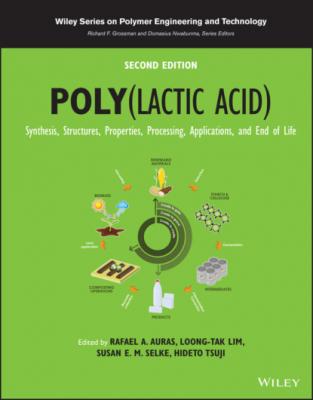Poly(lactic acid). Группа авторов
Читать онлайн.| Название | Poly(lactic acid) |
|---|---|
| Автор произведения | Группа авторов |
| Жанр | Химия |
| Серия | |
| Издательство | Химия |
| Год выпуска | 0 |
| isbn | 9781119767466 |
5.4.1 Single‐Step Process
The formation of sc‐PLA usually occurs by blending PLLA/PDLA, which requires synthesis of the individual polymers by the ring‐opening polymerization (ROP) of L‐ and D‐lactides prior to blending the respective enantiomeric PLA chains. The sc‐PLA thus formed exhibits improved thermal and mechanical properties; however, the process requires the formation of enantiopure polymers from the respective enantiopure monomers, which restricts its practical applications. In this regard, the single step preparation of sc‐PLA has been explored from the readily available racemic lactide (rac‐LA, or DL‐lactide, 1 : 1 mixture of L‐ and D‐lactides), which is inexpensive (Figure 5.1). The ROP of rac‐LA usually yields amorphous polymers (atactic or heterotactic) having lower T g and T m than those of the isotactic PLA, i.e., PLLA and PDLA. The random arrangement of L‐ and D‐lactide units in the backbone chain is usually observed upon polymerizing rac‐LA with a limited scope of application. To extend the utilization of rac‐LA precursor, significant efforts have been made in achieving the stereoselective polymerization of LA that causes the resulting stereochemistry in the product [41–43). The direct formation of sc‐PLA from rac‐LA has been achieved by Radano et al. using triethylaluminum‐based catalysts [44]. The formation of sc‐PLA is supported by XRD analysis; however, the lower degree of isotacticity reduces the T m of the resulting polymer to ~191°C as compared with ~230°C of the usual sc. The degree of crystallinity of sc‐PLA is ~42% as determined from the enthalpy of fusion (ΔH fus). In another study, semicrystalline stereoblock copolymers with HMW (~461 kg/mol) have been produced from rac‐LA using chiral oxazolinyl aminophenolate magnesium complexes. The isoselective control of the magnesium complexes is affected by the chirality of the ligand, which may be modified to develop more efficient catalysts [45]. Furthermore, the ROP of rac‐LA by a series of achiral iron complexes has been performed by Marin et al. to yield HMW stereoblock copolymers [46]. The stereoselective catalysts permit the formation of stereoblock copolymers under mild conditions. The catalyst complex also influences the tacticity of the resulting polymers and the stereochemistry. The thermal degradation temperature of the isotactic stereoblock PLA is increased up to ~350°C, which is reasonably dependent on its molecular weight [46]. The degradation temperature correlates more strongly with the molecular weight than with the stereoregularity. The developed stereoblock PLA having high molecular weight may be used for industrial applications.
TABLE 5.1 Unit Cell Parameters Reported for the sc Crystals
| Okihara et al. [32] | Brizzolara et al. [34] | Cartier et al. [33] | Sawai et al. [35] | Tashiro et al. [36] | |
|---|---|---|---|---|---|
| Crystal system | Triclinic | Triclinic | Trigonal | Trigonal | Trigonal |
| Chain conformation | 31 | 31 | 31 and 32 | 31 and 32 | 31 |
| Unit cell parameter | |||||
| a (nm) | 0.916 | 0.912 | 1.498 | 1.50 | 1.494 |
| b (nm) | 0.916 | 0.913 | 1.498 | 1.50 | 1.494 |
| c (nm) | 0.870 | 0.930 | 0.870 | 0.823 | 0.862 |
| α (°) | 109.2 | 110 | 90 | 90 | 90 |
| β (°) | 109.2 | 110 | 90 | 90 | 90 |
| γ (°) | 109.8 | 109 | 120 | 120 | 120 |
| ρ calc (g/cm3) | 1.27 | 1.21 | 1.27 | 1.342 | — |
FIGURE 5.1 Stereoblock PLA formation from rac‐LA in a single step.
5.4.2 Stepwise ROP
The well‐known sequential polymerization has largely been employed to develop stereoblock PLA with high molecular weight and crystallinity [47]. The formation of diblock copolymers of PLLA and PDLA was first reported by Yui et al. by adopting the sequential ROP strategy using aluminum tris(2‐propanolate) as a catalyst [48]. The interaction between the enantiomeric block sequences of di‐stereoblock (di‐sb) copolymers resulted in the formation of sc crystals with little homo‐crystallization. The molecular weight of the diblock copolymers was reported to be ~20 kDa; however, it is often essential to obtain the polymers with HMW (more than 100 kDa) in order to render them processable and dimensionally stable for possible applications. The two‐step ROP of L‐ and D‐lactides has been conducted to form di‐sb copolymers (PLLA–PDLA) where stannous octoate (Sn(Oct)2) was employed as a catalyst (Figure 5.2). The prepolymer (PLLA or PDLA) having a molecular weight of <50 kDa was prepared in the first step and then purified to remove the residual lactide prior to synthesizing di‐sb PLA having different block ratios of PLLA/PDLA in the second stage of ROP. The di‐sb‐PLA had a M w > 150 kDa, which, when solution‐cast into films, showed the formation of exclusive sc crystals. However, the heat deflection temperature of the di‐sb PLA having a non‐equivalent PLLA/PDLA ratio was somewhat lower, and the di‐sb‐PLAs having complementary PLLA/PDLA ratios were blended to adjust the whole PLLA/PDLA ratio to 50/50 and to increase the sc crystallinity [49]. In another study, tri‐stereoblock (tri‐sb) PLAs (ABA) having non‐equivalent block compositions were prepared by a two‐step ROP in the presence of 1,12‐dodecanediol as an initiator. The bis‐hydroxyl terminated PDLA was prepared in the first stage of ROP and purified to remove the residual D‐lactide. In the second stage of ROP, L‐lactide
